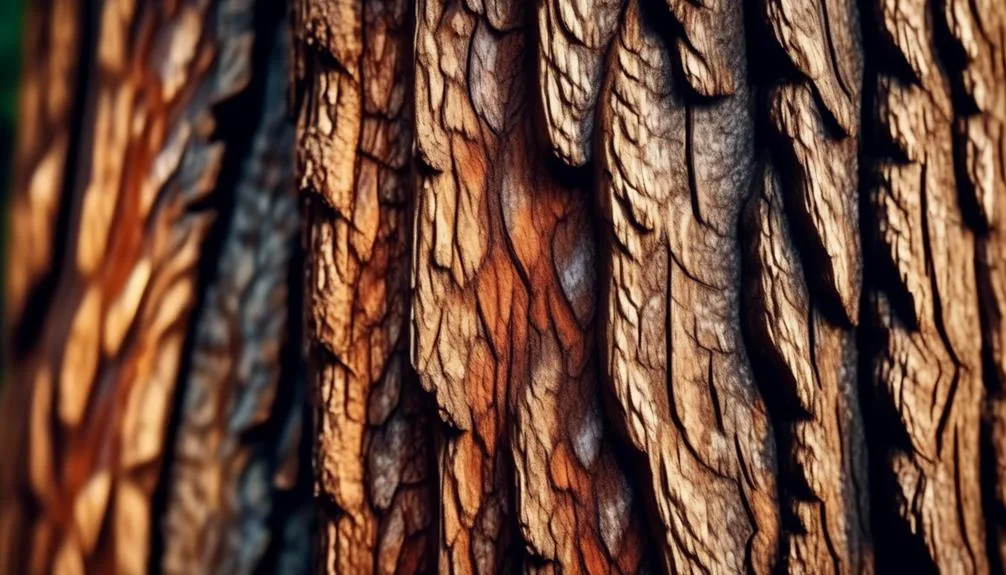The thick bark of redwood trees serves as a protective shield. But have you ever wondered why it's so robust? Understanding the reasons behind this natural armor unveils a story of evolution and survival. Redwoods have developed remarkable adaptations to thrive in their environment, making them resilient giants. Exploring the secrets behind their bark reveals a fascinating tale of nature's ingenuity.
Evolutionary Adaptation
How have redwood trees evolved to develop such thick bark, and what advantages does this adaptation provide?
Redwood trees have undergone a remarkable evolutionary process to withstand their specific environment. Through natural selection, these giants have developed thick bark as a climate adaptation for survival.
The unique ecological advantage of this thick bark lies in its ability to protect the tree from various environmental stressors, such as fire, drought, and insect infestations. The bark acts as a shield, insulating the inner layers of the tree from extreme temperatures, preventing moisture loss, and deterring destructive pests.
This adaptation has played a crucial role in the resilience and longevity of redwood trees, allowing them to thrive in their challenging habitats. The evolutionary development of thick bark showcases the remarkable ability of nature to equip species with the tools necessary for survival.
Protection Against Fire
To withstand the threat of wildfires, redwood trees have developed a remarkable defense mechanism in the form of their thick, fire-resistant bark. This protective feature allows them to survive and even thrive in fire-prone environments. The bark of redwood trees can be up to a foot thick, acting as a natural shield against intense heat. This fire resistance is crucial not only for the survival of individual trees but also for the entire ecosystem they support. Redwoods play a vital role in their ecosystem and provide habitat for numerous plant and animal species. The impact of their fire-resistant bark extends beyond their own survival, as it helps maintain the overall biodiversity and stability of the forest.
| Fire-Resistant Bark Benefits | ||
|---|---|---|
| Protection for tree's vital cambium layer | Shield for seeds and saplings | Safeguard for ecosystem diversity |
Resistance to Pests
Redwood trees naturally resist pests through the production of chemical compounds in their foliage, deterring potential insect damage and contributing to their overall resilience in forest ecosystems.
The bark structure plays a crucial role in this defense mechanism. Redwood bark contains tannins, which give it a reddish hue and a bitter taste. These tannins act as natural pest deterrents, making the tree less susceptible to insect infestations.
Additionally, the thick bark serves as a protective barrier, making it difficult for pests to penetrate and cause harm to the tree.
This pest resistance is a key factor in the longevity and survival of redwood trees, allowing them to thrive and maintain their majestic presence in the diverse ecosystems they inhabit.
Efficient Water Management
With their efficient water management system, redwood trees maintain their resilience in forest ecosystems, ensuring their survival and continued presence in diverse habitats.
The thick bark of redwood trees serves as a remarkable barrier, providing insulation that helps regulate the tree's internal temperature and minimize water loss. This bark insulation acts as a protective shield against extreme environmental conditions, enabling the tree to conserve moisture during dry periods and prevent excessive water loss.
Additionally, the bark's unique structure allows for effective moisture retention, crucial for sustaining the tree's growth and vitality. Redwood trees have evolved to efficiently manage water, a key factor contributing to their ability to thrive in various ecological settings and endure challenging circumstances.
This exceptional adaptation underscores the redwood's remarkable capacity to persist in dynamic forest environments.
Longevity and Growth Potential
In their towering presence, the redwood trees stand as living testaments to the remarkable longevity and growth potential inherent in their majestic form. These ancient giants hold valuable insights into environmental impact and sustainable growth, making them a subject of fascination for researchers.
Here's why redwoods are so remarkable:
- Environmental Impact: Redwoods play a vital role in their ecosystems, influencing soil quality, water retention, and providing habitats for diverse species.
- Tree Ring Analysis: By studying the annual growth rings of redwoods, scientists gain crucial knowledge about historical climate patterns, forest health, and the trees' response to environmental changes.
- Resilience and Adaptability: Redwoods have evolved strategies for surviving wildfires, pests, and diseases, reflecting their exceptional resilience in challenging environments.
- Unparalleled Growth Potential: Their ability to rapidly grow and regenerate contributes to their significance in combating climate change and sustaining biodiversity.
The redwoods' enduring presence continues to inspire and inform our understanding of sustainable growth and ecological resilience.
Conclusion
Intriguingly, the thick bark of redwood trees serves as a remarkable example of nature's adaptation for survival. Its multi-faceted role in protecting against fire, resisting pests, and regulating water underscores the resilience and longevity of these magnificent trees.
Contemplating their ability to endure and thrive prompts us to ponder the intricate balance of nature and the enduring legacy of these ancient giants.

My interest in trees started when I first saw the giant sequoias in Yosemite.
I was a teenager then, and I remember thinking, “I need to learn more about this.”
That moment stuck with me.
A few years later, I went on to study forestry at Michigan Tech.
Since graduating, I’ve worked in a mix of hands-on tree care and community education.
I’ve spent over ten years helping people understand how to plant, maintain, and protect the trees in their neighborhoods.
I don’t see trees as just part of the landscape.
They are living things that make a real difference in our daily lives.
